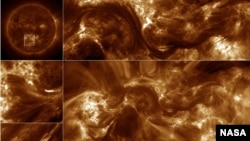Five or 10 minutes is not a long time when it comes to a NASA mission, but it was long enough for NASA's High Resolution Coronal Imager, or Hi-C, telescope to capture the sharpest images ever taken of the sun's scorching atmosphere.
The sun's surface is about 5,000 degrees Celsius, but its atmosphere can be millions of degrees hotter. Scientists, including Hi-C mission principal investigator Jonathan Cirtain, are working to figure out what energy source is heating the solar atmosphere.
"This high temperature atmosphere is where space weather is initiated and where energetic events like flares and coronal mass ejections can originate," Cirtain told reporters during a NASA teleconference. "So understanding the energy supply for the corona has implications across the stellar structure and heliophysics, in general."
Watch video of Hi-C's observations of the sun (Courtesy: NASA)
Watch video of Hi-C's observations of the sun (Courtesy: NASA)
NASA launched a suborbital rocket carrying the telescope last July. Hi-C snapped 165 images of an active region in the sun's corona, and the telescope could see features in the solar atmosphere that were only 150-kilometers across.
NASA says that is the equivalent of spotting a coin from six kilometers away.
The new images show magnetic loops that twist around each other to resemble braids, and when the braids unravel, there are simultaneous increases in energy emission. This supports a theory developed 30 years ago that the magnetic field could be supplying the energy that fuels solar flares and coronal mass ejections.
An astrophysicist at the Lockheed Martin Advanced Technology Center in California, Karel Schrijver, said solar storms have an effect in space and on Earth.
"Our society is increasingly dependent on space technology for navigation and communication, and we can't even imagine living without electricity," said Schrijver. "Yet, the largest of these solar storms could cause enormous problems and may damage large parts of the power grid or disable the navigation systems."
NASA astrophysicist Cirtain, who is based at the Marshall Space Flight Center in Alabama, says he would like to see a satellite version of the Hi-C telescope. He says scientists' ability to forecast space weather could mitigate solar storms' economic and societal impacts.
The Hi-C findings are published in the journal Nature.






